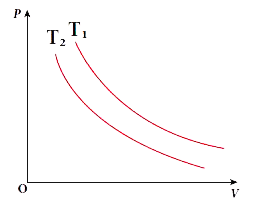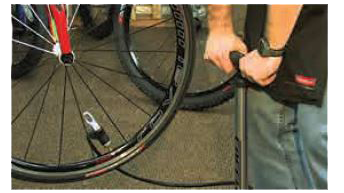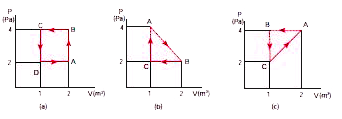Complete Solutions to Example of chapter HEAT AND THERMODYNAMICS of Class 11 book with complete answers and questions
| Class 11 | PHYSICS |
| Chapter | HEAT AND THERMODYNAMICS |
| TAMILNADU GOVT | Example |
| Number Of Questions | 27 |
| Academic Year | 2023-24 |
'A lake has more rain'.
(b) 'A hot cup of coffee has more heat'.
What is wrong in these two statements?
View SolutionA student comes to school by a bicycle whose tire is filled with air at a pressure 240 kPa at `27^(@)`C. She travels 8 km to reach the school and the temperature of the bicycle tire increases to `39^(@)`C. What is the change in pressure in the tire when the student reaches school?
View SolutionWhen a person breaths, his lungs can hold up to 5.5 Litre of air at body temperature `37^(@)C` and atmospheric pressure `("1 atm = 101 kPa")`. This Air contains `21%` oxygen. Calculate the number of oxygen molecules in the lungs.
View SolutionCalculate the volume of one mole of any gas at STP and at room temperature (300K) with the same pressure 1 atm.
View SolutionEstimate the mass of air in your class room at NTP. Here NTP implies normal temperature (room temperature) and 1 atmospheric pressure

View SolutionEiffel tower is made up of iron and its height is roughlyl 300 m. During winter season (January) in France the temperature is `2^(@)C` and in hot summer its average temperature `25^(@)C`. Calculate the change in height of Eiffel tower between summer and winter. the linear thermal expansion coefficient for iron `alpha=10xx10^(-6)per" "^(@)C`

View SolutionIf 5 L of water at `50^(@)C` is mixed with 4L of water at `30^(@)C`, what will be the final temperature of water ? Take the specific heat capacity of water as `4184J" "kg^(-1)K^(-1)`.
View SolutionA hot water cools from `92^(@)C` to `84^(@)C` in 3 minutes when the room temperature is `27^(@)C`. How long will it take for it to cool from `65^(@)C` to `60^(@)C` ?
View SolutionThe power radiated by a black body A is `E_(A)` and the maximum energy radiated was at the wavelength `lamda_(A)`. The power radiated by another black body B is `E_(B)=NE_(A)` and the radiated energy was at the maximum wavelength, `(1)/(2)lamda_(A)`. what is the value of N?
View SolutionWhen you mix a tumbler of hot water with one bucket of normal water, what will be the direction of heat fl ow? Justify.
View SolutionA student had a breakfast of 200 food calories. He thinks of burning this energy by drawing water from the well and watering the trees in his school. Depth of the well is about 25 m. Th e pot can hold 25L of water and each tree requires one pot of water. How many trees can he water? (Neglect the mass of the pot and the energy spent bywalking.Take`g=10ms^(-2)`)

View SolutionA person does 30 kJ work on 2 kg of water by stirring using a paddle wheel. While stirring, around 5 kcal of heat is released from water through its container to the surface and surroundings by thermal conduction and radiation. What is the change in internal energy of the system?
View SolutionJogging every day is good for health. Assume that when you jog a work of 500 kJ is done and 230 kJ of heat is given off . What is the change in internal energy of your body?
View SolutionGive an example of a quasi-static process.
View SolutionA gas expands from volume `1m^(3)` to `2m^(3)` at constant atmospheric pressure.
(a) Calculate the work done by the gas.
(b) Represent the work done in PV diagram.
View SolutionA 0.5 mole of gas at temperature 300 K expands isothermally from an initial volume of 2 L to 6 L
(a) What is the work done by the gas?
(b) Estimate the heat added to the gas ?
(c) What is the final pressure of the gas ? (The value of gas constant, `R=8.31J" "mol^(-1)K^(-1)`)
View SolutionThe following PV curve shows two isothermal processes for two diff erent temperatures and. Identify the higher temperature of these two.

View Solution
We often have the experience of pumping air into bicycle tyre using hand pump.Consider the air inside the pump as a thermodynamic system having volume V at atmospheric pressure and room temperature, `27^(@)C`. assume that the nozzle of the tyre is blocked and you push the pump to a volume 1/4 of V. calculate the final temperature of air the pump ? (For air, since the nozzle is blocked air will not flow into tyre and it can be treated as an adiabatic compression).
View SolutionThe following graph shows a V-T graph for isobaric process at two different presures. Identify which one occurs at higher pressure.

View SolutionOne mole of an ideal gas intially kept in a cylinder at pressure 1 MPa and temperature `27^(@)C` is made to expand until its volume is doubled.
(a) How much work is done if the expansion is (i) adiabatic (ii) isobaric
(iii) Isothermal?
(b) Identify the process in which change in internal energy is least and is maximum.
(c) Showeach process on PV diagram.
(d) Name the processes in which the heat transfer is maximum and minimum. (Take `gamma=(5)/(3) and R=8.3J" "mol^(-1)K^(-1)`)
View Solution500 g of water is heated from `30^(@)C` to `60^(@)C`. Ignoring the slight expansion of water, calculate the change in internal energy of the water ? (Specific heat of water 4184 J/kg.K)
View SolutionThe PV diagrams for a thermodynamical system is given in the figure below. Calculate the total work done in each of the cyclic processes shown

View SolutionGive some examples of irreversible processes. All naturally occuring processes are irreversible. Here we give some interesting examples. (a) When we open a gas bottle, the gas molecules slowly spread into the entire room. Th ese gas molecules can never get back in to the bottle.

(b) Suppose one drop of an ink is dropped in water, the ink droplet slowly spreads in the water. It is impossible to get the ink droplet back. (c) When an object falls from some height, as soon as it hits the earth it comes to rest. All the kinetic energy of the object is converted to kinetic energy of molecules of the earth surface, molecules of the object and small amount goes as sound energy. The spreaded kinetic energy to the molecules never collected back and object never goes up by itself.
View SolutionDuring a cyclic process, a heat engine absorbs 500 J of heat from a hot reservoir, does work and ejects an amount of heat 300 J into the surroundings (cold reservoir). Calculate the effi ciency of the heat engine?
View SolutionA steam engine boiler is maintained at `250^(@)C` and water is converted into steam. This steam is used to do work and heat is ejected to the surrounding air at temperature 300K. Calculate the maximum efficiency it can have?
View SolutionThere are two Carnot engines A and B operating in two different temperature regions. For Engine A the temperatures of the two reservoirs are `150^(@)C` and `100^(@)C`. For engine B the temperatures of the reservoirs are `350^(@)C` and `300^(@)C`. Which engine has lesser efficiency?
View SolutionA refrigerator has COP of 3. How much work must be supplied to the refrigerator in order to remove 200 J of heat from its interion?
View Solution
Example questions and complete solutions for chapter HEAT AND THERMODYNAMICS of FULL MARKS PHYSICS(TAMIL) of Class 11